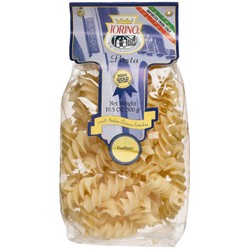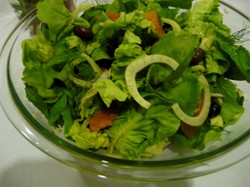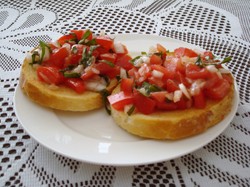
Bronze pasta
Bronze pasta is the queen of dried pastas - its porous surface means that it soaks up the flavour of pasta sauces. And you can easily buy it online too.
I adore Italian food and if I want to cook something economical, tasty and relatively quick, then I'll usually go for a pasta dish, such as spaghetti bolognaise or pasta shells/quills with homemade pesto verde. Because of my keen interest in the subject, I often I get into conversations with people about cooking and cooking ingredients. One day, when the discussion turned to Italian food, the subject of dried pasta came up. "Of course, you should really buy bronze pasta if you're going to buy dried pasta at all", I was told. "It gives much better results than ordinary dried pasta." "Bronze pasta - what on earth is that?", I said. "Surely the bronze doesn't mean the colour." On further enquiry, I discovered that no, the "bronze" part doesn't refer to the colour of the pasta, but to the way it's made - more on this below.
By a strange coincidence, I happened to be wondering around my local branch of Aldi the next day and in the big metal baskets that make up middle aisle there were all these exotic types of dried pasta, including several varieties of bronze pasta. It was too good an opportunity to miss, so I bought a packet then and there (you have to grab the opportunities when you can at Aldi… if you were to go back a few days later, you'd find that the pasta had disappeared, only to be replaced by shampoo. Or bargain-priced woks. Or sweet chilli sauce. Aldi really is that random.)
Anyway, I cooked the bronze pasta up with some bolognaise sauce and it lived up to its promise - it had a pleasant, firm texture and absorbed the flavour of the sauce very efficiently. And that's the salient point about bronze pasta: it's more porous than the "normal" kind of pasta, which means that it soaks up whatever sauce you make with it. It's therefore particularly good for oven-baked pasta dishes, where you mix the sauce up with the pasta and an optional cheesy topping, before baking for - say - 20 minutes.
If you want to buy some bronze pasta but your local stores don't sell it, have a look at the Amazon.com capsules down the right hand side of this hub; there are plenty of varieties of bronze pasta available and they even do multi-packs.
How dried pasta is produced
Pasta is usually made from durum wheat - the word "durum" means "hard" in Latin and this quality of hardness is what makes the pieces of pasta hold together when they're cooked! Once the wheat has been harvested, the ears are milled to remove the husk, leaving the bran, wheatgerm and endosperm.
Available on Amazon.com
 | Torino Bronze Die Pasta Fusilloni, 10.5-Ounce Bags (Pack of 9) |
 | Torino Bronze Die Pasta Bombolini, 10.5-Ounce Bags (Pack of 9) |
 | Torino Bronze Die Pasta Mezzi Paccheri, 10.5-Ounce Bags (Pack of 9) |
 | L'antica Rocca Pappardelle, 16-Ounce Bag (Pack of 2) This pasta in exclusively produced with organically grown durum wheat semolina from the Orcia Valley in Tuscany, an area with an extraordinary vocation for good food, such as ... |
 | Bucatini by Latini- Linea Classica Selection Pasta Latini Linea Classica Selection- high quality Italian Durum Wheats Produced in Osimo, in the Marche region, pasta Latini has all the great qualities of artisanal pasta. ... Only $6.00 |
The endosperm is the "white" bit so if white pasta is the ultimate end product, then the bran and wheatgerm are removed as well. In its unground state, the endosperm can be used to make couscous or tabbuleh. When coarsely ground, it's known as semolina. It's semolina which is used as the basis for pasta.
The semolina is mixed with water to give a dough. Other ingredients can be added at this stage, such as egg or spinach (spinach is what makes green pasta green). The dough is kneaded rather like bread, and once it's the right texture, it's extruded through a die, i.e. a disc with holes punched in it, before being dried and packed. (The shape of the holes determines what shape pasta you end up with.) This is where the "bronze" bit comes in. Modern commercial dried pasta is usually made with plastic dies, but bronze pasta is extruded through dies made from bronze metal. It's the slightly rough surface of the metal that imparts a porous finish to the pasta shapes, thus ensuring that they absorb whatever sauce they're cooked with. Buon appetito!
© Empress Felicity September 2010
Available on Amazon.com
 | Spaghetti Chitarra by Latini- Linea Classica Selection Pasta Latini Linea Classica Selection- high quality Italian Durum Wheats Produced in Osimo, in the Marche region, pasta Latini has all the great qualities of artisanal pasta. ... Only $6.00 |
 | Lensi Pasta Chef Spaghetti, 16-Ounce Paper Bags (Pack of 20) |
 | L'antica Rocca Linguine, 16-Ounce Bag (Pack of 2) This pasta in exclusively produced with organically grown durum wheat semolina from the Orcia Valley in Tuscany, an area with an extraordinary vocation for good food, such as ... |
 | Lensi Pasta Chef Penne, 16-Ounce Paper Bags (Pack of 20) Lensi Pasta Chef Penne is Picture Quill Shaped Pasta . It’s a short, ridged tube cut on the bias, which makes it a great vessel for olive oil based sauces. It means striped ... |
You might also like
Fennel Salad With Goat's Cheese, Butter or Red Leaf Lettuce, O...Fennel is a flavorful herb. It is particularly nutritious and healthy in sala...
Italian Bread With Plum Tomatoes: The Joy of BruschettaItalian bread can be eaten in bite-sized chunks or politely cut slices. Eithe...



 Sterling silver bird pendants and charmson 12/04/2011
Sterling silver bird pendants and charmson 12/04/2011
 Pink storage boxes, containers, units and basketson 12/04/2011
Pink storage boxes, containers, units and basketson 12/04/2011
 Buy container graters onlineon 12/03/2011
Buy container graters onlineon 12/03/2011
 Animal themed door knockerson 12/03/2011
Animal themed door knockerson 12/03/2011



Comments